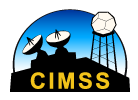On 22 June and 23 June 2015 there were multiple fires in Alaska that produced pyroCb. GOES-15 detected the smoke plumes and pyroCb clouds, as well as the fire hot spots. Starting at 21:00 UTC on 22 June, the animation below shows visible (.63 μm) on the left and shortwave IR (3.9 μm) on the right (click image to play animation). In the shortwave IR images the red pixels indicate very hot IR brightness temperatures exhibited by the fire source region.

GOES-15 0.63 μm visible (left) and 3.9 μm shortwave IR (right) images (click to play animation)
Also the GOES-15 10.7 μm IR channel images helped to analyze the cloud-top IR brightness temperatures (below; click to play animation).

GOES-15 10.7 μm IR images (click to play animation)
The first pyroCb was seen at 64.2º N 149.4º W around 21:45 UTC on 22 June. GOES-15 is magnified to this specific pyroCb and detects the smoke plume and the hotspot from this particular fire. Starting at 21:00 UTC the animation below shows visible (.63 μm) on the left and shortwave IR (3.9 μm) on the right (click image to play animation). In the shortwave IR images the darker black to red pixels indicate very hot IR brightness temperatures exhibited by the fire source regions.

GOES-15 0.63 μm visible (left) and 3.9 μm shortwave IR (right) images (click to play animation)
Also, using GOES-15 10.7 μm IR channel the cloud-top IR brightness temperature could be determined. The animation below starting at 21:00 UTC shows the brightness temperature of this pyroCb reaching -47.2 ºC (lime green color enhancement) around 21:45 UTC.

GOES-15 10.7 μm IR image (click to play animation)
The second pyroCb was located at 65.9º N 149.1º W, starting around 01:00 UTC on 23 June. GOES-15 is magnified to this specific pyroCb and detects the smoke plume and the hotspot from this particular fire. Starting at 00:00 UTC on 23 June the animation below shows visible (.63 μm) on the left and shortwave IR (3.9 μm) on the right (click image to play animation). In the shortwave IR images the darker black to red pixels indicate very hot IR brightness temperatures exhibited by the fire source regions.

GOES-15 0.63 μm visible (left) and 3.9 μm shortwave IR (right) images (click to play animation)
Also, using GOES-15 10.7 μm IR channel the cloud-top IR brightness temperature could be found. The animation below starting at 00:00 UTC shows the brightness temperature of this pyroCb reaching -58.4 ºC (yellow color enhancement) around 06:00 UTC.

GOES-15 10.7 μm IR image (click to play animation)
The third pyroCb was located at 65.4º N 151.7º W, and started around 2:00 UTC on 23 June. GOES-15 is magnified and centered to this specific pyroCb and detects the smoke plume and the hotspot from this particular fire. Starting at 02:00 UTC on 23 June the animation below shows visible (.63 μm) on the left and shortwave IR (3.9 μm) on the right (click image to play animation). In the shortwave IR images the darker black to red pixels indicate very hot IR brightness temperatures exhibited by the fire source regions.

GOES-15 0.63 μm visible (left) and 3.9 μm shortwave IR (right) images (click to play animation)
Also, using GOES-15 10.7 μm IR channel the cloud-top IR brightness temperature could be found. The animation below starting at 05:00 UTC shows the brightness temperature of this pyroCb reaching -51.4ºC (lime green color enhancement) around 06:00 UTC.

GOES-15 10.7 μm IR image (click to play animation)
There are two additional pyroCb that have occurred: the fourth at 65.º N 148.3º W, and the fifth at 65º N and 153.6º W. Since there are so many pyroCbs in the area it hard to distinguish between the different pyroCbs. With this being said the images for these pyroCbs can be seen in the above animations. The fourth pyroCb was found to have a minimum brightness temperature of -47.6º C, and the fifth pyroCb a minimum brightness temperature of -47.2º C. These are indicated by a lime green color enhancement in the GOES-15 10.7 μm IR channel animations.
The overpass of the Suomi NPP satellite at 12:00 UTC on 23 June allowed a better view of the pyroCb clouds and the smoke that was produced from these fires. The VIIRS true-color image below shows the many different fires that were occurring and the pyroCbs that resulted from some of the larger fires. Widespread smoke from this fire activity can also be seen, which exhibits a hazy white to light tan appearance.

Suomi NPP VIIRS True-Color image on 23 June (click to enlarge)
On 22 June OMPS Aerosol Index (AI) images were useful to see the transport of the smoke. From the AI image (below; courtesy of Colin Seftor), it can be seen that the smoke was being transported southwestward.

OMPS Aerosol Index image on 22 June (click to enlarge)
In addition, the image below shows a MODIS true-color image with an overlay of the OMPS Aerosol Index (courtesy of Colin Seftor).

MODIS true-color image with an overlay of OMPS Aerosol Index on 22 June (click to enlarge)
Again on 23 June OMPS AI Index images were used to see the transport of the smoke. From the AI images below (courtesy of Colin Seftor), the smoke is now moving eastward. At 20:40 UTC the max AI was 7.5 at 65.3 N and 142.18 W. Also, at 22:20 UTC the max AI was 6.7 at 65.32 N 141.28 W. From these AI values it is apparent the smoke is now moving eastward into Canada, which is different from the previous day.

OMPS Aerosol Index images on 23 June (click to enlarge)




























